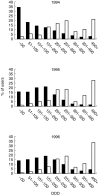Lack of adherence to lipid-lowering drug treatment. A comparison of utilization patterns in defined populations in Funen, Denmark and Bologna, Italy
- PMID: 10792204
- PMCID: PMC2014946
- DOI: 10.1046/j.1365-2125.2000.00192.x
Lack of adherence to lipid-lowering drug treatment. A comparison of utilization patterns in defined populations in Funen, Denmark and Bologna, Italy
Abstract
Aims: The objective was to explore differences in lipid-lowering drug (LLD) prescribing in Italy and Denmark.
Methods: We used two geographical areas with computerized drug prescription records in defined populations, one in Funen, Denmark with 500 000 inhabitants, the other in Bologna, Italy with 400 000 inhabitants. Prescriptions for patients who had purchased a LLD from 1994 until 1996 were retrieved as well as coprescriptions of antidiabetic and cardiovascular drugs as markers for diabetes and cardiovascular disease. Only patients surviving and remaining in the area were included. Compliance was defined as percentage of DDDs purchased divided by the number of days within the time window. The limit between good and poor compliance was set at 82%.
Results: In Bologna, LLD consumption measured in DDD increased by 41% and in Funen by 129%. Annual prevalence increased from 36.9 to 46.3 users/1000 inhabitants from 1994 to 1996 and from 3.2 to 6.6 users/1000 inhabitants in Bologna and Funen, respectively. From 1995 to 1996, the incidence of use decreased slightly in Bologna from 19.3 to 18. 8/1000 inhabitants/year, whereas in Funen the incidence increased from 1.8 to 2.3/1000 inhabitants/year. In Bologna 48% and in Funen 91% of users persisted with treatment for 2 years or longer. In Bologna, 7% and in Funen 45% were good compliers. In Bologna, 61% and in Funen, 72% received other drugs indicating cardiovascular or diabetic comorbidity.
Conclusions: Patterns of use differed substantially between the two areas. In contrast with Funen, where long-term use was common, Bologna LLD use was sporadic. Based on a higher rate of coprescription, LLDs seemed to be used for secondary prevention to a higher extent in Funen than in Bologna. In Funen it appeared that the correct patients, but an insufficient number of them, were being treated adequately according to guidelines. The higher discontinuation rate of lipid lowering drugs in the Bologna area indicates that a large proportion of patients use these drugs for too short a period of time to benefit from treatment. Since society's health care resources are limited it is difficult to justify public funding of these medications without at the same time giving appropriate attention to these problems.
Figures



References
-
- Magrini N, Einarson T, Vaccheri A, McManus P, Montanaro N, Bergman U. Use of lipid-lowering drugs from. 1990 to 1994: an international comparison among Australia, Finland, Italy (Emilia Romagna Region), Norway and Sweden. Eur J Clin Pharmacol. 1997;53:185–189. - PubMed
-
- Scandinavian Simvastatin Survival Group. Randomised trial of cholesterol lowering in 4444 patients with coronary heart disease: the Scandinavian Simvastatin Survival Study (4S) Lancet. 1994;344:1383–1389. - PubMed
-
- Shepherd J, Cobbe SM, Ford I, et al. Prevention of coronary heart disease with pravastatin in men with hypercholesterolemia. West of Scotland Coronary Prevention Study Group. N Engl J Med. 1995;333:1301–1307. - PubMed
-
- Simons LA, Levis G, Simons J. Apparent discontinuation rates in patients prescribed lipid-lowering drugs. Med J Aust. 1996;164:208–211. - PubMed
-
- Andrade SE, Walker A, Gottlieb LK, et al. Discontinuation of antihyperlipidemic drugs – do rates reported in clinical trials reflect rates in primary care settings? N Engl J Med. 1995;332:1125–1131. - PubMed
Publication types
MeSH terms
Substances
LinkOut - more resources
Full Text Sources
Medical
Research Materials

